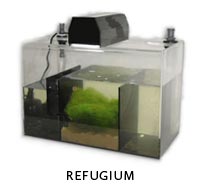Refugiums
A refugium is basically an extension to your existing tank, sharing the same water supply and filtration system, but not allowing larger creatures to cross over. As the name suggests, refugiums form refuges from predators.
The exact purpose might be a place to raise live food without it all getting eaten at once, a nursery, biological filtration, or simply a safe place for the more fragile aquarium invertebrates.
Refugium Positioning
 A refugium works best when positioned as close to the main tank as possible.
This could be above, below or alongside.
Don't have the refugium tucked away in a cabinet below unless the organisms within have no need of light and you have no desire to see them.
This means that, unless the purpose is solely biological filtration, the refugium should be placed in a similar spot to the original tank.
Positioning the refugium at a level higher or lower level allows you to take advantage of gravity for part of the water transfer process.
A refugium works best when positioned as close to the main tank as possible.
This could be above, below or alongside.
Don't have the refugium tucked away in a cabinet below unless the organisms within have no need of light and you have no desire to see them.
This means that, unless the purpose is solely biological filtration, the refugium should be placed in a similar spot to the original tank.
Positioning the refugium at a level higher or lower level allows you to take advantage of gravity for part of the water transfer process.
Refugium Basics
A range of purpose-built refugiums are available, but a refugium is essentially nothing more than a second, usually smaller, tank with a pump to transfer water to and from the original tank. If you are handy with aquarium technology, it shouldn't take you long to set up a refugium with a small, cheap tank and a suitable pump.
Precautions
Ensure that the water entering the refugium comes from below the surface of the main tank, not the overflow. A thriving, established aquarium contains all sorts of organic materials, some of which will float to the surface. Overflow water is therefore liable to be saturated with oils, proteins and other waste, overloading the refugium. The idea is to have a refuge with equal water quality, not a dump for organic matter. If you plan to set up a nutrient-heavy affair to culture phytoplankton or similar organisms, you’d be better off with a completely separate tank.